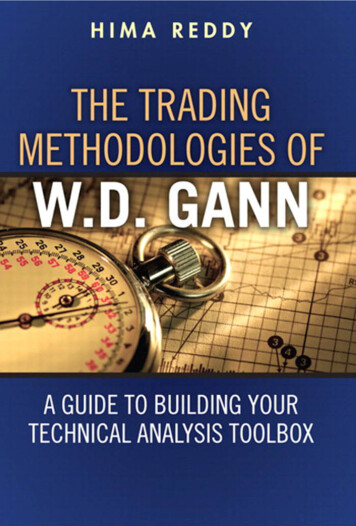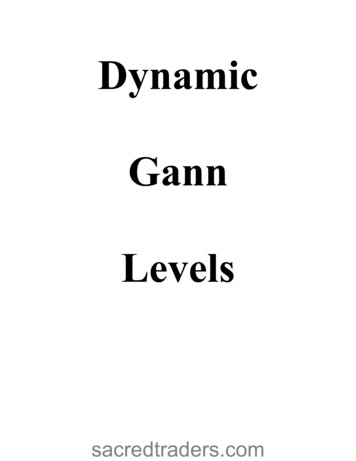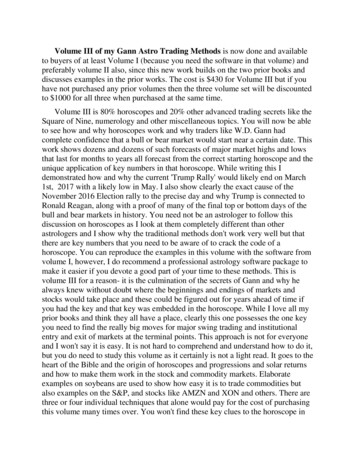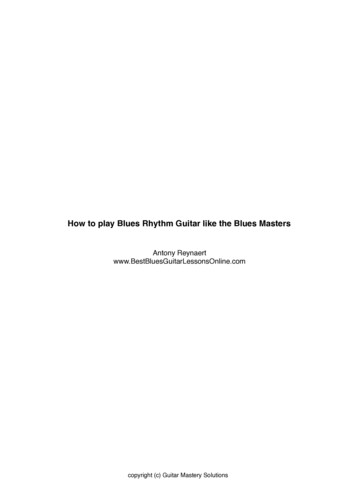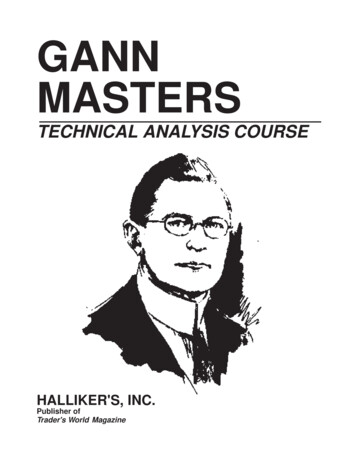
Transcription
GANNMASTERSTECHNICAL ANALYSIS COURSEHALLIKER'S, INC.Publisher ofTrader's World Magazine
2Gann Masters(c) 1995 Halliker's, Inc., ALL RIGHTS RESERVED. No part of this publication may be reproduced, stored in a retrieval system, or transmitted, in anyform or by any means, electronic, mechanical, photocopying, recording, orotherwise, without the prior written permission of the publisher.This course was prepared from information believed to be reliable but notguaranteed by us without further verification and does not purport to be complete. Opinions expressed are subject to revision without notification. We arenot offering to buy or sell securities or commodities discussed. Halliker's Inc.or one or more of it's officers, and or authors may have a position in thesecurities or commodities discussed herein. The names of the products andservices presented in this course are used only in editorial fashion and to thebenefit of the trademark owner with no intention of infringing on trademarkrights. Products and services in this course are subject to availability and pricesare subject to change without notice.The charts in the publication are printed by permission of Omega Research.They are developed from SuperCharts and TradeStation. Spread sheet examples were developed by the Microsoft Excel Spreadsheet program and areprinted with permission of Microsoft Corporation.This course is dedicated to Stella Bittel who recently passed away. She hadthe endurance to fight diabetes for the last fifty years.Printed in the United States of AmericaHalliker's, Inc.2508 W. Grayrock Dr.Springfield, MO 65810Phone (417) 882-9697Fax (417)886-5180
Gann MastersCONTENTS.Chapter 1W.D. GANN A LEGEND.5Chapter 2STUDY AND BE PREPARED.15Chapter 3CAPITAL REQUIRED.21Chapter 4RIGHT KIND OF CHARTS.23Chapter 5KNOW THE TREND.31Chapter 6MATHEMATICS.36Chapter 7ELLIOTT WAVE THEORY.54Chapter 8THE TIME FACTOR.65Chapter 9SUPPORT AND RESISTANCE.72Chapter 10TIME AND PRICE OVERLAYS.77Chapter 11TABLE CHARTS.90Chapter 12TIME AND PRICE ANALYSIS.110Chapter 13FORECASTING TIME.121Chapter 14FORECASTING PRICE.1363
4Gann MastersChapter 15EXCEL SPREAD SHEET.145Chapter 16SWING CHARTS.147Chapter 17GAPS.150Chapter 18TOPS AND BOTTOMS.152Chapter 19VOLUME AND OPEN INTEREST.156Chapter 20GANN CHANNELS.160Chapter 21TYPES OF ORDERS.163Chapter 22MAKING IT WORK.165Appendix ATEST APPLICATION.168Appendix BCERTIFICATION.170Appendix CCATALOG SUPPLIES.172
Gann MastersCHAPTER 1W.D. GANN A LEGEND.W.D. Gann grew up around cotton warehouse where cotton was king.William Delbert Gann was born June 6, 1878, in Lufkin, Texas, toSam H. and Susan R. Gann, immigrants to Texas from the British Isles.Lufkin is midway between Houston and Texarkana. This part of Texas is cotton country and Gann’s parents lived on a Neches River bottom cotton ranchnear Lufkin. He grew up around the cotton warehouses in Angelina Countywhere cotton was king. W. D. Gann was raised in a very strict Methodistchurch family. His mother, a very religious person, encouraged him to readthe Bible at a very early age, and in fact, wanted him to become a minister.Gann was not sure he wanted to become a minister, but studying the Biblewas certainly easier than working in the cotton fields, as was his father’swish. He attended church every Sunday with his parents and as he listened tothe sermons found his interpretation of the Bible scriptures to differ from theminister’s. In the Bible he discovered time cycles, repetition of importantnumbers, and references to the wise men following the stars. Also, that it waswritten in veiled language that made interpreting the real meaning difficult.Since Gann had a photographic memory, by age 21 he had nearly memorizedthe Bible.During his school years Gann excelled in mathematics and was generally called as a gifted mathematician. His tremendous appetite for knowledgeand his open-minded attitude led him into many different fields of study thateventually resulted in discoveries in the markets that would otherwise havebeen overlooked. He completed high school in a time when most childrenwere only able to attend school through the third or fourth grade.As a teenager, Gann liked to be called W. D., and he used these initialsthe rest of his life. W. D. pestered his parents until they relented and signed aminor release form that he needed to obtain a job. His first job was that of aNews Butcher on the passenger train between Texarkana and Tyler, Texas.This job required him to be quick-witted, aggressive, and able to deal with allkinds of people. During his teen years, he worked in the cotton warehouses inLufkin and Texarkana, Texas. While working in the cotton warehouse, he wasintroduced to commodity trading.5
6Gann MastersIn 1902, at age 24, W. D. Gann made his first commodity trade in cotton,the market he knew best. The small profit from that trade marked the beginning of what was to become one of the most remarkable and legendary careers the speculative markets have ever known. Over the next 53 years, Ganntook over 50,000,000 from the markets. It has been reported by a man whoworked for Gann the last eight years of Gann’s life, that approximately 1/3 ofthe money he made was for himself and the other 2/3 was for the accounts hesupervised for clients. From that very first trade, it is believed Gann was using principles and techniques he continued using throughout his trading career. The notations on some of his early charts substantiated this belief. Astime progressed, his trading methods were refined.In 1906 W. D. went to Oklahoma City. He worked as a broker for a brokerage firm, trading for himself while handling large accounts for clients. Hestudied the cause of success and failure in the speculation of other traders. Hefound that over 90% of traders who enter the markets without knowledge andstudy usually lose in the end. Gann also lost a significant amount of moneyand admitted his trading was based on hope, greed, and fear. Later on, in hisbooks and courses, he cautioned all traders about these emotions.Early on, Gann began to note the periodical recurrence of rise and fall instocks and commodities. This led him to conclude that natural law was thebasis of market movements. He then devoted ten years to the study of naturallaw as applicable to the speculative markets. During that time he traveled toEngland, Egypt, and India to gain knowledge in ancient mathematics andastrology. In the British Museum in England he conducted extensive researchon market cycles. In an Egyptian temple it is believed he found the basicconstruction of what was to become known as his Square of 9 Chart. Afterexhaustive research and investigation of the known sciences, he discoveredthe Law of Vibration enabled him to accurately determine the exact prices towhich stocks or commodities would trade within a given time, and that eachstock or commodity had its own rate of vibration.At age 27, Gann was a well-known name in the Southwest. His views onthe analysis of cotton prices were so well respected that a Texarkana newspaper, The Daily Texarkanian, ran a story on Gann’s cotton predictions.In 1908, at age 30, Gann moved to New York and opened his own brokerage office at 18 Broadway. He began testing his theories and techniques inthe market. On August 8, 1908, he made one of his greatest mathematicaldiscoveries for predicting the trend of stocks and commodities. This was “TheMaster Time Factor.” Within a year, it became clear to others that his successwas based on more than just luck. No one researched time cycles as extensively as Gann. His charts show the cycles with which he worked, went backto history’s beginning, and bore no resemblance to other researcher’s timecycle studies.
Gann MastersIn October 1909, Richard D. Wyckoff, Owner and Editor of The Tickerand Investment Digest asked Gann for an interview to document his tradingability for one month. The interview was granted, and Gann’s trades weremonitored for 25 market days during the month of October in the presence ofa Ticker representative. At that time the markets also traded on Saturday. Gannmade 286 trades in various stocks, both long and short. There were 264 tradesthat resulted in profits and 22 in losses. 92.3% of the trades were profitable.The capital used doubled ten times resulting in 1000% gain on his originalinvestment during those 25 trading days. What makes this even more phenomenal is that Gann did this with an average time between each trade ofabout twenty minutes. In one day Gann made 16 trades in the same stock, 8 ofwhich were in either the top eighth or the bottom eighth of that particularswing. Such a performance is unparalleled in the history of Wall Street. Asstated by James R. Keene, the famous speculator of that era, “The man who isright 6 times out of 10 will make his fortune.”It seems a foregone conclusion that Gann was picking tops and bottomswith a high degree of accuracy. At this point of time, in 1909, he was only 31years of age, so whatever methods he was using had already been discovered.This biographer believes that after his sensational performance Gann regretted having granted the interview, as it was stated in the printed article thathe did not know the results were to be published. When the article was printedin The Ticker Investment Digest, Gann was besieged with people asking howhe was able to pick tops and bottoms as he had demonstrated. His only answer to them was he used The Law of Vibration to make all his calculations.At this conjuncture there were only two choices: l) to give away his secretdiscoveries and risk destroying the markets, or 2) to detract from his methodof picking tops and bottoms by writing books and courses about mechanicaltrading systems, the use of geometrical anges, the use of Time and Price Charts,such as the Octagon Chart (Square of 9), Master 12 Chart (Square of 144),Hexagon Chart (the cube), Square of 90, Square of 52, 360 Degree CircleChart, and many other trading techniques.If Gann had continued trading using only his method of picking tops andbottoms, without a doubt he would have become one of the wealthiest men inthe world, and in so doing would have attracted too much attention. He wouldhave been asked too many questions by traders and would have been compelled to explain. However, at certain times, he probably used his method toadvantage. Gann had a profound understanding of natural law, so rather thanplace himself in an embarrassing situation, he chose to trade using his mechanical systems and other techniques he had developed. Also, having morecapital than was required for a good living was not important to him, as hewas more interested in the knowledge possessed by ancient civilizations andthe occult sciences. Gann understood how the Laws of Nature controlled hu-7
8Gann Mastersman beings and, therefore, he understood the markets, because the marketsare nothing more than an expression of the actions of human beings.The two previous paragraphs are my belief. You may agree or disagree,but before you arrive at a conclusion, carefully study Gann’s 1909 tradingdemonstration. He made 286 trades in 25 days, which is 11 trades per day. Todo this, you must pick the tops and bottoms on a short intraday time period.If what I believe is true, it is very sad to think that a genius individualsuch as W. D. Gann, had to disguise the truth throughout his life, with a smokescreen of many trading methods and techniques.In 1918 his office address in New York was 81 New Street and in theearly 1920’s was at 49 Broadway. Over the years, Gann maintained severaloffices in New York all located on Wall Street with the address numbers of78, 80, 82, 88, 91, 93 and 99.At the height of Gann’s career, he employed 35 individuals who madecharts of all kinds, did analytical research at his direction, and performedmany duties involved with his various publications and services. The name ofone of his businesses was W. D. Gann Scientific Service, Inc., and the other,initiated in 1919, was W. D. Gann Research, Inc. The firms published thefollowing Supply and Demand Letters: Daily Stock Letter, Tri-Weekly StockLetter, Weekly Stock Letter, Daily Commodity Letter, Tri-Weekly Commodity Letter, and Weekly Commodity Letter. Telegraph Service was all offeredas follows: Daily Telegraph Service on Stocks, Daily Telegraph Service onCotton, Daily Telegraph Service on Grain, and Telegrams on importantChanges Only, on Stocks or Commodities. Published under Annual Forecastswere: Annual Stock Forecast, Annual Cotton Forecast, Annual Grain Forecast, Annual Rubber Forecast, Annual Coffee, Sugar and Cocoa Forecast.Supplements to all Forecasts were issued and mailed on the first of each month.Special Forecasts on stocks or other commodities were made on request. Alsooffered were daily, weekly, monthly, quarterly, and swing charts on stocksand commodities. Gann taught advanced courses of instruction entitled Master Forecasting Method, at a cost of 2,500, and New Mechanical Methodand Trend Indicato
books and courses, he cautioned all traders about these emotions. Early on, Gann began to note the periodical recurrence of rise and fall in stocks and commodities. This led him to conclude that natural law was the basis of market movements. He then devoted ten years to the study of natural law as applicable to the speculative markets. During that time he traveled to England, Egypt, and India .




